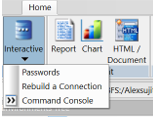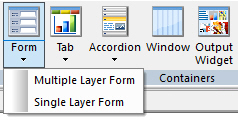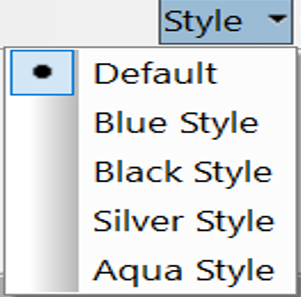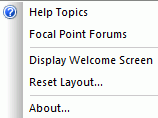The WebFOCUS App Studio ribbon replaces traditional toolbars
with a single command bar that organizes commands and controls into
a series of static and contextual tabs. From the ribbon, you can
also access the Style menu and the
Help menu.
The default ribbon is shown in the following image.
Each tab on the ribbon, whether static or contextual, contains
commands and controls that are organized into groups, according to
their function or relationship. All tabs are named and all groups
are labeled. Icons are used to represent the commands or controls
in each group. By default, all icons are labeled. There are a few
styling icons in the Style group that are not labeled. Rest your
pointer over an icon to view the tooltip that identifies it. An example
of this is shown in the following image.
In addition to single-click commands, some commands on the ribbon
contain a submenu of options that opens when you click the arrow
associated with the command. These arrows can appear below or next
to a label. An example of this are the Data and Form commands, which opens
a submenu of options, as shown in the following image.
Note: There is no default ribbon size. As your monitor
or application window size changes, the commands and controls on
the ribbon resize themselves to fit the available space. Large monitors
or application windows will display larger icons and entire groups.
Smaller monitors or application windows may display groups as a
single, labeled icon that opens a submenu.
Building an Application Using the Home Tab
The Home tab enables you to access the features and functions
necessary to build an application, create new components, open existing
components, run existing components, and edit components. The Home
tab contains the Data, Content, Configure, and View groups. The
Home tab is always available and is static. It is located in the
upper-left corner of the WebFOCUS App Studio interface, below the Quick Access
Toolbar, as shown in the following image.
Note: The Home tab is the only static tab in App Studio.
Managing Data Using the Data Group
The Data group includes tools that you can use to connect to data, upload data, edit metadata, and manage data access. The
Data group is shown in the following image.
The commands in the Data group are:
- Interactive
-
Contains the following options:
- Passwords. The Password dialog box opens. You
can enter the password for the data source you have selected in
your Environments Tree panel.
- Rebuild a Connection. The Rebuild dialog box opens. You can rebuild
a disorganized file, index a specific field from a file, or check
the integrity of a file.
- Command Console. Opens a command tab for editing and enables you to send commands directly
to a server from WebFOCUS App Studio. For more information on creating, viewing,
and editing source syntax, see Creating,
Viewing, and Editing Source Syntax in WebFOCUS App Studio.
Sending Commands to the Server Using the Command Console
The
Command Console enables you to send commands directly to a server
from WebFOCUS App Studio. This benefits users who have worked with Information
Builders products and are already familiar with the command syntax.
The Command Console sends output to your web browser or WebFOCUS App Studio
Viewer. Output can include error messages, responses to query commands,
and report output. The Command Console can also serve as a troubleshooting
and debugging tool.
The following are a set of rules that you should follow when
entering commands in the command console.
- The Console is case sensitive. Therefore, you must enter
text in the case required for processing. For example, keywords
must be entered in uppercase characters.
- The Command Console is not interactive. Therefore, you must
enter all required commands in sequence and execute them as an entire
process. For example, you must enter all steps required to execute
the WebFOCUS REBUILD command. The Console does not prompt you for
information.
- You can copy or cut text from the Command Console or an outside
window, and paste it in the Command Console.
- You can drag command syntax within the Command Console.
The following groups are available in the Command Console Ribbon tab.
Listing the Available Paths Using the Execution Path Group
The Execution Path group contains a list of paths that
are available for you to use when you execute commands. The Execution
Path group is shown in the following image.
The command is:
- Execution Path List
-
Contains a list of available paths for you to execute commands.
The
list of available execution paths is determined by the selected
nodes in the Environments Tree panel. When you open WebFOCUS App Studio for
the first time, you must expand and select a node from the Environments
Tree panel to populate the Execution Path List.
When you run
the content of the console, it will be executed using the selected execution
path and the Reporting Server associated with that selected path.
Loading Commands Using the Edit Group
The Edit group allows you to load commands, clear the
console, and clear the input stack. The input stack is a series
of commands that you enter using the Command console. The Edit group
is shown in the following image.
The commands are:
- Back
-
Loads the previous command from the input stack.
- Forward
-
Loads the next command from the input stack.
- Clear Console
-
Clears the current commands from the console.
- Clear Input Stack
-
Clears the previously entered commands from saved memory.
This option is unavailable if you do not have previously entered
commands available for recall.
- Auto Clear Console
-
When selected, automatically clears the console after your
commands are executed.
Note: The Command Console tab shares the following groups
with the Text Editor tab: Find, Bookmarks, Position, Case/Comment,
and Options. For more information on these remaining groups, see Creating,
Viewing, and Editing Source Syntax in WebFOCUS App Studio.
Creating an Application Using the Content Group
The Content group contains the components or tools that you can
use to create an application. These include: Report, Chart,
and HTML/Document. The Content group is shown in the following image.
The commands in the Content group are:
- Report
-
Opens the Report canvas in report mode after you enter a
procedure name and select a location for your report from the Report
Wizard.
In report mode, you can
create and style simple or complex reports, add data to the Report
canvas, and style that data creating a graphical representation
of the report page. This allows you to view how the report displays
at run time.
Using report mode, you can:
- Display
and sort data.
- Select records.
- Include totals, subtotals, column calculations, headings, footings,
and images.
- Format columns.
- Style fonts, colors, and grids.
- Add drill downs to detailed reports and URLs.
- Save output in many types of formats for display and reuse.
- Create HTML Analytic Documents.
- Perform predictive analysis (an RStat license is required).
- Chart
-
Opens the InfoAssist Chart canvas after you enter a procedure name and
select a location.
In chart mode, you can easily transform almost
any type of data into effective custom charts. You can create a
variety of charts, such as bar charts, line charts, scatter charts,
or pie charts, to help users analyze data in a different way. You
can include selection criteria by defining parameters for your data.
Additionally, you can apply drill-down capabilities and conditional
styling to highlight specific data on a chart.
The Chart canvas
contains a ribbon of features and options that allow you to add and
style the data in your chart. Contextual tabs open within the Chart
canvas, rather than on the App Studio ribbon.
- HTML/Document
-
Opens the HTML/Document Wizard. You can choose the type of
page that you want to create from the following options: HTML Page,
Guided Report Page, or Document. Depending on your selection, the
corresponding canvas will open.
HTML mode provides the
features you need to create HTML pages so that end users can interact
with your data. You can build and customize an HTML page in the HTML
canvas, using the contextual tabs on the ribbon to add objects to
the page. HTML mode is fully integrated with JavaScript and cascading
style sheets (CSS).
In the HTML canvas, you can:
- Build an HTML launch
page.
- Add push buttons, hyperlinks, and other controls to launch WebFOCUS
reports in your application.
- Create a launch page for one or more reports that contain parameters.
- Create a complete HTML page by adding multiple reports and
charts.
- Create an advanced report layout by including images, frames,
and other web objects.
- Modify the location, size, and properties of all objects in
your page layout.
- Set background, font, and other page properties.
In
the Document canvas, you can coordinate and distribute layouts made
up of multiple reports and charts in a single document. You can
position reports and charts anywhere on a single page or combine
a series of layouts within a single document. When creating compound
reports in the Document canvas, PDF, HTML, HTML and PDF Analytic Documents, PowerPoint,
and Excel are available as output formats.
Deploying an RStat Scoring Routine Using the Modeling Group
The
Modeling Group is only available when RStat is installed. You can
deploy an RStat scoring routine or estimate future values based
on selected data.
WebFOCUS RStat is a statistical modeling workbench embedded in
WebFOCUS App Studio. It allows you to perform common statistical and data
mining tasks, and develop models that can be deployed as scoring
applications on every platform. RStat enables data miners and Business
Intelligence developers to collaborate with the same tools used
to access, manipulate, or transform data, develop predictive models,
and create and deploy scoring applications along with associated
reports to any worker within their organization. The Modeling group
is shown in the following image.
The commands in the Modeling Group are:
- Model Deployment
-
Opens the Model Deployment dialog box. This functionality
enables you to deploy existing, stored routines.
You can deploy
an RStat scoring routine in any application directory within your
app path on any WebFOCUS server. The process of deployment includes
compiling the routine and placing the executable file in a location
that can be accessed by a WebFOCUS scoring application.
- Predictive Modeling
-
Opens RStat, a statistical modeling workbench that is embedded
in WebFOCUS App Studio. When you select the Predictive Modeling command,
the RGui window is opened and the R Console and RStat are activated.
You
use RStat to derive expected and predicted values from data observations. Decision
trees, regression, and the other algorithms are used to generate
estimates. For example, you can estimate whether a prospect is a
good target for a particular marketing campaign, or you can estimate
the expected sales revenues for different stores in order to determine
whether store layout and product mix have an impact on sales.
Controlling the Display of the Screen Using the View Group
The View Group enables you to control what displays on your screen.
For example, you can choose whether to display or hide the Environments
Tree or Help Wizard. The View group is shown in the following image.
The commands in the View group are:
- Environments Tree
-
Displays or hides the Environments Tree panel, which displays
on the left side of the screen and displays environment information.
- Environments Detail
-
Displays or hides the Environments Detail panel.
- File/Folder Properties
-
Displays or hides the File/Folder Properties panel.
- Procedure View
-
Displays or hides the Procedure View panel.
- Context Bar
-
Displays or hides the Context Bar. The Context Bar displays
under the ribbon.
- Status Bar
-
Displays or hides the Status Bar. The Status Bar displays
along the bottom of the screen.
- Help Wizard
-
Displays or hides the Help Wizard. The Help Wizard content dynamically changes, depending on where you are in the interface.











